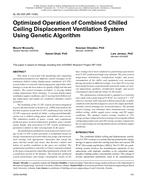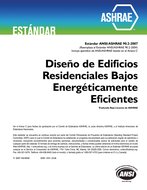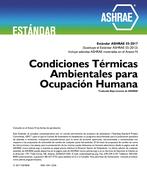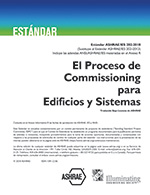Description
This paper is based on findings resulting from ASHRAE Research Project RP-1438.
This study is concerned with optimizing and comparing operational parameters for different control strategies of the combined chilled ceiling displacement ventilation (CC/DV) system subject to transient load using genetic algorithm while aiming to create the best indoor air quality (IAQ) and thermal comfort. The control strategies included: 1) varying chilled ceiling temperature (base strategy), 2) varying displacement ventilation supply conditions, and 3) varying both chilled ceiling temperature and supply air conditions (multiple control variables).
The modeling of the CC/DV system operation integrated a space thermal model of Ayoub et al. (2006) that predicts the thermal response inside the CC/DV conditioned zone with the CC/DV component models of chiller, cooling and dehumidification coil, a chilled ceiling panel, and chilled water circuit. The simulation models of space, system, and components predicted space vertical temperature gradient, space stratification height, and associated CC/DV system performance parameters subject to time-varying loads in the space.
An optimization problem for each proposed control strategy of the CC/DV system operation is formulated based on energy consumption of system chiller, fan, pump, and reheat for each strategy with appropriate constraints that satisfy the space thermal model and insure that thermal comfort and indoor air quality conditions in the space are satisfied. The optimization problem is solved for a 24 hour repeated schedule in the space using genetic algorithm optimization scheme with a prediction period of 60 minutes. The predicted optimized system performance and energy consumption results of the base strategy have been validated by performing experiments in a CC/DV conditioned single zone chamber. The zone vertical temperature distribution, stratification height, and power consumption of the chiller and equipment were measured during operation at different settings. Less than 8% error has been found between experimentally measured values of vertical temperature gradient, stratification height, and power consumption and predicted values by the model.
The optimization scheme/model is applied to a transient case study with a peak load of 93 W/m2 in a room of 5 × 5 m2 with two external walls exposed to Beirut typical day weather condition of the month of August to assess the single and multivariable control strategies for best performance. The optimal control strategy was obtained when simultaneously varying chilled ceiling, chiller supply water setting, and DV supply conditions. The optimal control strategy resulted in 15% energy savings compared to base strategy of varying the chilled ceiling temperature only and 10% energy savings compared to the second strategy of varying displacement ventilation supply conditions.
Units: SI
Citation: ASHRAE Transactions, vol. 114, pt. 2, Salt Lake City 2008
Product Details
- Published:
- 2008
- Number of Pages:
- 14
- File Size:
- 1 file , 2.5 MB
- Product Code(s):
- D-SL-08-055




